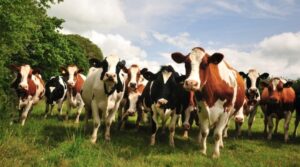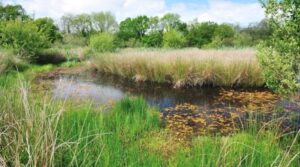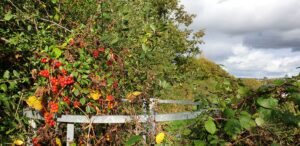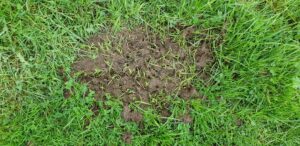Pasture Champions: Elfyn and Rhian Davies, Glancynin Farm, St Clears, Carmarthenshire, West Wales 1/2
Tell us about your farm, it's location, size, altitude, climate, soils, enterprises, organic/PfL/other status?
 Meuse Rhine Issel cows
Meuse Rhine Issel cows
Glancynin is a 70 hectare Pasture for Life and organic certified dairy farm on the lower reaches of the Cynin river at St Clears, Carmarthenshire, West Wales.
The farm is situated near where the Cynin meets the tidal part of the river Taf at the quay. They both then run down to the sea past Dylan Thomas's boathouse and shed at Laugharne, and where he wrote Under Milkwood.
The farm is 18m at the yard, rising to 30m above sea level at the highest point. We have a rainfall of 1250mm in St Clears. The farm is in a dip and is often a few degrees colder than the surrounding, higher land. Our soils are heavy loam with underlying clay, making for very wet ground in winter, except the river fields which are productive alluvial silt.
Our Meuse Rhine Issel cows graze tree-lined herbal-rich river meadows, producing sweet creamy milk, rich in minerals - milk made by cows eating grass, not by man in a factory.
Young heifers graze conservation fields, where three wildlife ponds were created, all surrounded by mature trees, studded hedgerows and some younger stock graze the orchard.
Share with us a general description of the biodiversity on your farm – essentially above ground, but reference to below ground if relevant, both flora and fauna.
Glancynin is teaming with wildlife; our ponds are full of frogs, toads and newts in Spring, and dragonflies and damselflies in Summer.
 Wildlife pond
Wildlife pond
A few years ago I saw a buzzard with what I thought was a rope wrapped around her foot. I approached the bird and on closer inspection the rope turned out to be a grass snake, it gave me quite shock as I’m scared of snakes.
It’s not unusual to see the brilliant blue streak of a kingfisher flying past when walking the fields on the banks of the river Cynin, or a dipper bobbing on the rocks.
Otters have returned to the river in more recent years and whilst the river still supports fish, not the numbers of salmon and sewen that the river was once renowned for. Our species rich hedgerows are alive with birds and small mammals, particularly in autumn when the mature hedges are laden with fruit.
 Species rich hedgerow
Species rich hedgerow
Foxes and badgers use the hedges to move around the farm and as a result, they don’t seem to spend as much time out in the open. Bats and barn owls hunt along the hedgerows, woodland, streamside corridors at night.
The cattle attract insects, bringing the bats and birds that feed off them. Our grasslands haven’t been ploughed since we arrived at the farm in the 1990s and we have multi species swards in which the moles have returned. The dung beetles break down the dung and provide food for birds and bats, as well as the flora and fauna below ground. These are signs that nature is returning to balance.
 Cow pat pecked by birds
Cow pat pecked by birds



